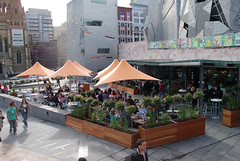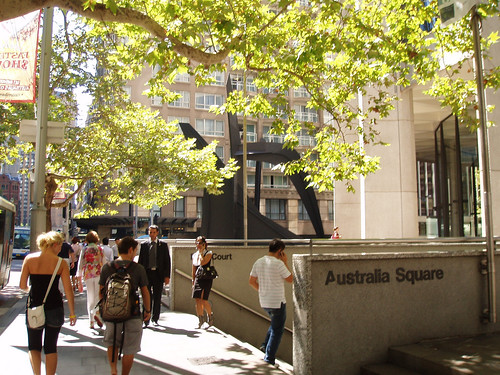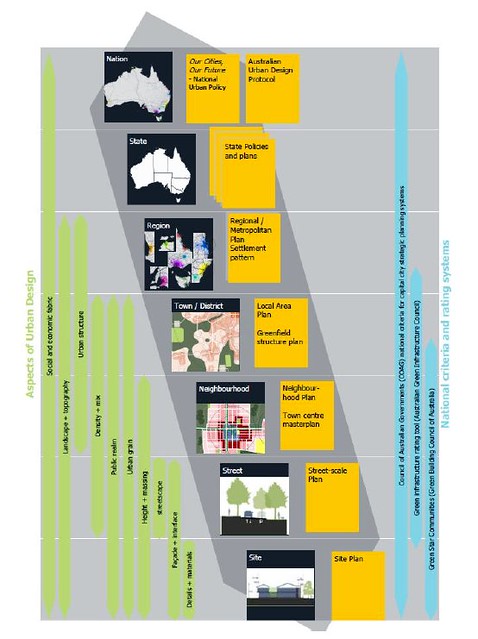Australia outlines national city design principles

Posted November 2, 2011 at 2:06PM
Today’s post is co-authored with my colleague Marissa Ramirez.
The government of Australia has released the final draft of a report encouraging “world class design” for the nation’s cities. Its title, Creating Places for People, signals from the beginning that this is about design with a purpose: broadly, creating a built environment that supports the lives of the Australian citizenry.
The report is far from prescriptive. Indeed, it is somewhat abstract, featuring a “protocol” of hierarchies and flow charts of planning and design elements and objectives, with few live examples. But it does take a holistic approach to design, focusing on both humans and urban form. The interplay between people and places is expressed across a transect of scales from regions all the way down to buildings. The principles in the protocol are said to be based on lessons learned from the Australia’s best performing cities and addresses urban challenges on different scales.
The report explains why city design matters:
“Urban design can significantly influence the economic, environmental, social and cultural outcomes of a place:
- Urban design can influence the economic success and socio-economic composition of a locality – whether it encourages local businesses and entrepreneurship; whether it attracts people to live there; whether the costs of housing and travel are affordable; and whether access to job opportunities, facilities and services are equitable.
Urban design determines the physical scale, space and ambience of a place and establishes the built and natural forms within which individual buildings and infrastructure are sited. As such, it affects the balance between natural ecosystems and built environments, and their sustainability outcomes.
- Urban design can influence health and the social and cultural impacts of a locality: how people interact with each other, how they move around, and how they use a place.
“Although urban design is often delivered as a specific ‘project’, it is in fact a long-term process that continues to evolve over time. It is this layering of building and infrastructure types, natural ecosystems, communities and cultures that gives places their unique characteristics and identities.”
That’s as good a summary of the role of city form and design as I have seen recently. The report also stresses that design is manifested in multiple ways:
“Urban design occurs across all parts of a city, from the inner city to the middle suburbs and outer metropolitan fringes. Urban design is relevant from the largest to the smallest scale developments, whether they are city-wide transport and infrastructure networks, urban infill projects, regional towns, new suburban developments, shopping malls, office blocks, university campuses or hospitals.”
These ideas are embedded in the complex but logical chart above, which expresses the ways that design intention – the shaping of places, if you will – functions, from the national level all the way down to planning for neighborhoods, streetscapes, and building sites. On the right, the chart refers to criteria and rating systems against which one can measure planning. On the left are various design elements, such as landscape and topography, public realm, building height and size, and materials. In between are the scales at which design functions. The chart matches these factors schematically so that the reader can see, for example, that issues of density and mix are applied at the street, neighborhood, and town/district scale; the national and state scales are involved only with “social and economic fabric” and not with, for example, “urban grain.”
Thus, at the national scale, the Australian government can provide principles for sustainability, investment and coordination in cities. It can measure productivity and quality of life improvements as measures of success at the national level. At the local scale, designers and planners can build, for example, public parks for children replete with foliage and shade -- and they can use tools like Australia’s Green Infrastructure Rating criteria as a guide.
 Since much of this is elementary, the main significance of the design protocol may be that it signals that all levels of government have roles to play in fashioning healthy cities and a built environment that works for people. From the point of view of the current American political climate, in which the very idea of government is being resented and derided, that’s not a small thing.
Since much of this is elementary, the main significance of the design protocol may be that it signals that all levels of government have roles to play in fashioning healthy cities and a built environment that works for people. From the point of view of the current American political climate, in which the very idea of government is being resented and derided, that’s not a small thing.
Indeed, Australia has made significant progress over the past year to “ensure Australian cities are globally competitive, productive, sustainable, livable and socially inclusive and are well placed to meet future challenges and growth.” This work includes The State of Australian Cities, a report filled with over 250 pages of data on productivity, sustainability, and livability. The results show progress, in that people are using less energy and riding public transit more than in previous years; but it also observes that housing shortages and unemployment continue to be troubling issues in most places. These data are intended to provide “an evidence base to support the national urban policy.”
A national urban policy, now there’s an idea. Design can be viewed as a tool in implementing such a policy, and the urban design protocol as a reminder for design professionals of their importance to the goals of society. Of course, the degree to which principles are manifested in beneficial design improvements remains to be seen. But having a government that cares is a step in the right direction.
Move your cursor over the images for credit information.

